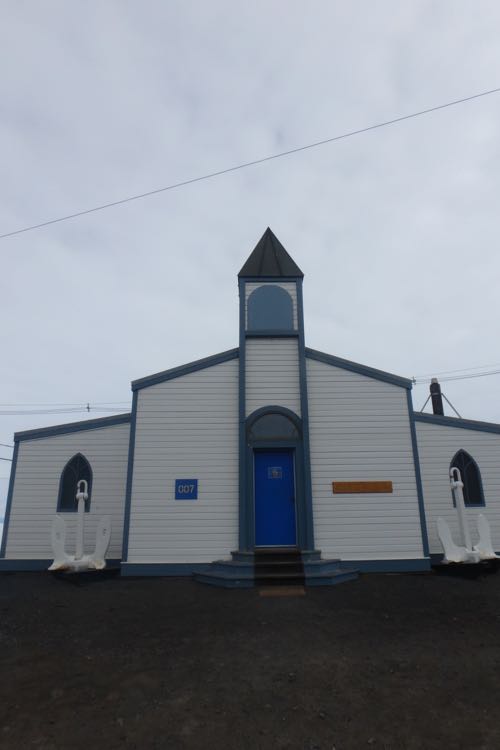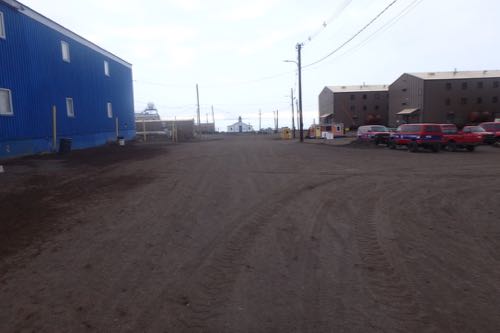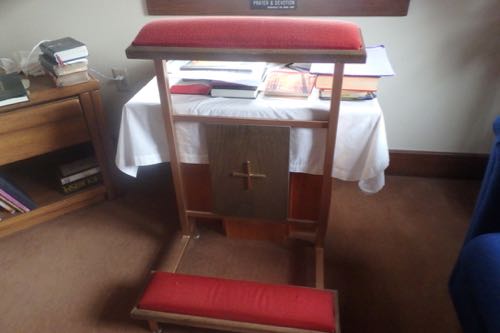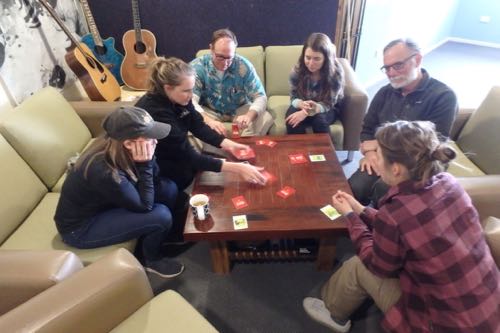 Church of the Snows.
Church of the Snows.
I have been on this expedition for four Sundays. Our training, travel, being weathered into field camps, and other activities, has not made it possible for me to go to church. I attended this morning. There were four of us in our congregation. We prayed, sang a song, had the sacrament, and shared a few thoughts with each other. The message shared by Dr. Byron Adams was to be still and listen for the whisperings from the Spirit of God. It was great to worship together.
The Chapel of the Snows is the second most southern church in the world. The original chapel burned down in 1978. This one was dedicated in 1989.
 You can see the Chapel of the Snows from almost everywhere on Station. The blue building on the left is where we all eat. McMurdo Sound is in the background.
You can see the Chapel of the Snows from almost everywhere on Station. The blue building on the left is where we all eat. McMurdo Sound is in the background.
 The Chapel is visible coming out of our dorms. Also, check out those red vehicles. See how they are adapted for Antarctic conditions?
The Chapel is visible coming out of our dorms. Also, check out those red vehicles. See how they are adapted for Antarctic conditions?
 This is the beautiful stained glass at the front of the chapel. Can you spot the Antarctic items in the glass? I can spot two.
This is the beautiful stained glass at the front of the chapel. Can you spot the Antarctic items in the glass? I can spot two.
It is thought that the altar came from the church in New Zealand where Robert Falcon Scott went to church. He was the explorer who reached the South Pole second and whose team died on the return trip.
 Altar in the Chapel of the Snows.
Altar in the Chapel of the Snows.
This is the Erebus Chalice. A marker in the chapel tells that Ms. Betty Bird of New Zealand donated this. She is a descendant of Admiral Edward Joseph Bird, who was aboard the ship Erebus which discovered, and named Ross Island. They also named Mt. Erebus. Ms. Bird had it engraved to honor Captain Robert Falcon Scott's ill-fated South Pole expedition. It was first used in the Chapel of the Snows in Antarctica on Christmas Day of 1987. It is here in Antarctica in the summer. In the winter, it goes to Christchurch, New Zealand. The chalice is then brought back on the first trip back to Antarctica by a chaplain.
 The Erebus Chalice.
The Erebus Chalice.
After church, we enjoyed 'Sunday brunch', put on in the galley. All the breakfast items you could ever dream of were there for us. There was even a huge shrimp bowl. Between the choices of food items, the quality, and especially the friendly service, I'd put the galley up against about any other buffet I have eaten at.
We were also invited for an evening at Scott Base. This is New Zealand's science station. We enjoyed some fun playing games and then we were treated to a great lamb dinner. I ran into some old friends there who I have worked with during my past few weeks here. I have really developed some great friendships here.
 The wormherders playing games in the lounge at the Scott Base with our Kiwi friends.
The wormherders playing games in the lounge at the Scott Base with our Kiwi friends.
To put the final touches to a great day, we heard Dr. David Ainley speak at the Sunday Science Talk in the galley. He is the world's expert on penguins. He spoke for about an hour telling us about his latest research regarding how penguins are doing and how we can look to them to see how climate change is effecting different populations on Earth. Here is a great article about Dr. Ainley and his work with penguins.
What an eye-opener it has been for me to finally realize that about every person here is probably the world's expert in their field of study. McMurdo is the gathering place for the world's top scientists.
Summary Of This Past Week: (check out past journals for details)
Monday: We conducted SLIME at Lake Bonney. Check out the journal for an explanation of SLIME.
Tuesday: Our flight out of Lake Bonney was cancelled due to weather. I did two hikes. One to the Rock Garden, and the other to Blood Falls.
Wednesday: Lab work at the Crary Lab. We separate animals from the collected soil. They were then identified, counted, and data recorded. I went to the McMurdo Medical Clinic for a great tour.
Friday: Repeat of Thursday's lab work. We toured the Coast Guard's Polar Star icebreaker.
Saturday: Byron, Matt, and myself flew to Garwood Valley to collect soil samples. Byron installed a soil sensor that will collect data for the year.
We hope to be back out into the Dry Valleys this next week. This will be the final push to get the field work done before the helicopters stop flying.


Comments
Add new comment